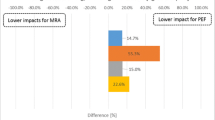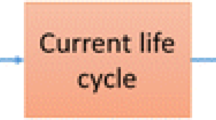Abstract
‘Design for Recycling’ and dematerialization by enhancing the durability of products are major aspects of the quest for sustainable products. This article presents an LCA-based model for the integrated analyses of the product chain, its recycling systems, and its waste treatment systems at the ‘End of Life’ stage. The model is an extension of the EVR (Eco-costs/Value Ratio) model which has been published in this journal (Vogtländer et al. 2001), but can also be applied to other life cycle interpretation models, since the model as such is not restricted to the use of the eco-costs as a single indicator. The model has been developed to evaluate the design alternatives of complex products like buildings and cars. These products comprise several subsystems, each with its own special solution at the End of Life stage: Extending of the product life, object renovation, re-use of components, re-use of materials, useful application of waste materials, immobilization with and without useful applications, incineration with and without energy recovery, land fill.
Since complex product systems always comprise a combination of these design alternatives, a methodology is given to calculate and allocate the eco-costs of the total system in order to select the best solution for sustainability. The methodology is characterized by:
-
•
A main allocation model of the recycling flow based on physical relationships,
-
•
a strict separation of the market value, the costs and the ecocosts in the system,
-
•
a main allocation model for extension of lifetime based on ‘depreciation of eco-costs’, parallel to economic depreciation.
Similar content being viewed by others
References
Ekvall T, Tillman A-M (1997): Open-loop recycling: criteria for allocation procedures. Int J LCA 2 (3) 155–162
Ekvall, T (2000): A market-based approach to allocation at open-loop recycling. Resources, Conservation and Recycling 29, 91–109
Frischknecht R (1998): Life cycle inventory analysis for decisionmaking. Scope-dependent inventory system models and context-specific joint product allocation. PhD dissenation ETH Nrl2599, Zürich, Switzerland
Gale BT (1994): Managing customer value, Free Press, New York
Gielen DJ (1999): Materialising dematerialisation. Integrated energy and materials systems engineering for greenhouse gas emission mitigation. Thesis Delft University of Technology, The Netherlands
Henley N, Shogren JF, White B (1997): Environmental economics, in theory and practice. Basingstoke, Mac Millan
Huisman J, Boks C, Stevels A (2000a): Environmentally weighted recycling quotes — better justifiable and environmentally more correct. Design for Sustainability Research Group, Delft University of Technology, Delft, The Netherlands
Huisman J, Boks C, Stevels A (2000b): Applications and implications of using environmentally weighted recycling quotes in assessing environmental effeccs in the end-of-life of consumer electronics. Design for Sustainability Research Group, Delft University of Technology, Delft, The Netherlands
Kim S, Hwang T, Lee KM (1997): Allocation for cascade recycling system. Int J LCA 2 (4) 217–222
Klöpffer W (1996): Allocation rule for open-loop recycling in life cycle assessment — A review. Int J LCA 1(1) 27–31
Lindeijer E, Huppes G (2000): Partitioning economic in- and outputs to product systems. Annex C from draft document ‘Life Cycle Assessment in Environmental Policy, Scientific Backgrounds’, CML, Leiden, www.leidenuniv.nl/interfac/cml/lca2/ index.html
Lindfors L-G, Christiansen K, Hoffman L, Virtanen Y, Juntilla V, Hanssen O-J, Ronning T, Ekvall T, Finnvelden G (1995): Nordic Guidelines on Life-Cycle Assessment, Nord 1995:20, Nordic Council of Ministers, Copenhagen
Pearce DW, Turner RK (1990): Economics of natural resources and the environment. Harvester Wheatsheaf, New York
Porter ME (1985): Competitive advantage. Free Press, New York
Van Nes CN, Cramer JM, Stevels ALN (1998): Determinants of replacement behaviour for electronic products. Care Innovation ’98, November 16–19, 1998, Austria Centre, Vienna, Austria
Seijdel R (1994): Toerekening Recycling: de Estafette-methode. PRC Bouwcentrum, Bodegraven
Sirkin T, Ten Houten M (1994): The cascade chain. A theory and tool for achieving resource sustainability with applications for product design. Resources, Conservation and Recycling 10, 213–277
Vogtlander JG, Brezet HC, Hendriks ChF (2001): The virtual eco-costs ’99: A single LCA-based indicator for sustainability and the eco-costs/value ratio (EVR) model for economic allocation. Int J LCA 6 (3) 157–166
Vogtländer JG, Bijma A (2000) The virtual pollution prevention costs ’99: A single LCA-based indicator for emissions. Int J LCA 5 (2) 113–124
Werner F, Richter K (2000): Economic allocation in LCA: A case study about aluminium window frames. Int J LCA 5 (2) 79–83
Author information
Authors and Affiliations
Corresponding author
Rights and permissions
About this article
Cite this article
Vogtländer, J.G., Brezet, H.C. & Hendriks, C.F. Allocation in recycling systems. Int J LCA 6, 344–355 (2001). https://doi.org/10.1007/BF02978865
Received:
Accepted:
Issue Date:
DOI: https://doi.org/10.1007/BF02978865




